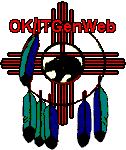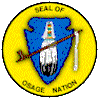 |
 |
 |
HO-WA (Welcome)
 Osage
Nation, Indian Territory
Osage
Nation, Indian Territory

If you have information that you would like to share with other researchers and would like to submit that information to the Osage site please contact the County Coordinator.

The Beginning...
According to the Osages, in the beginning the ancestors lived in the sky. When they asked Sun and Moon who their parents were, Sun said he was their father, and Moon said she was their mother. Then Moon said it was time for them to go down to the earth. As they descended, the people came upon water but no land. They floated in the air, calling for help, but no one came. Finally Elk, one of the animals floating down to earth with the people, came to everyone’s assistance by falling into the water. As he sank he called on the four winds to blow away the waters. A muddy surface appeared as the mist flew off. Then Elk rolled in the mud and the loose hairs that remained in the soil grew into grass and trees. Now the people, called the Little Ones, could continue their descent to the Middle World.
When people first came into the Middle World, it was necessary for them to explore their surroundings and organize their communities. The Osage tell how their ancestors, the Little Ones who came down from the sky, divided into three groups called the Water People, the Land People, and the Sky People. The Water People led as they wandered the Earth’s surface, learning about the seasons, and the plants and animals, and how to provide themselves with tools, weapons, clothing, and food. They came upon a river, and the spirit of the river told them how to be clean and pure. Then they came to the village of the Isolated Earth People. They were afraid to enter because the village was a place of death, decay, disease, and waste—what one might expect of Earth without the influence of the Sky. But the leader of the Isolated Earth People met with the leader of the Water People. They smoked the pipe and the Isolated Earth People leader said “I am of the Earth people and the red boulder is our symbol. It is red like the dawn and life everlasting. It is so strong that all things move aside for the red boulder.” The Water People leader said “Our bodies are of the red clay pipe we are smoking. We are Water People, and all things come to us for purification.” As they smoked, the two groups found kinship. The Water People gained strength, and the Isolated Earth People gained purification to know other things besides death and chaos. Two great divisions were formed out of all the people: The Sky People and the Earth People, the latter being further sub-divided into the Land and Water People. These became the two great divisions of the Children of the Middle Waters, symbolizing the universe of sky and earth and land and water.
(Source: Arkansas Acheological Survey)

Background Information...
The Osage, Ponca, Omaha, Kwapa (Quapaw), and Kansa Nations were the descendants of one great tribe of Indians whose first dwelling place was in the region of the Ohio and Wabash rivers. Soon they wandered westward, some going down the Mississippi and some ascending it.
The Omahas, which then included the Osage, Ponca, and Kansa group, ascended the Missouri river, but another separation took place when the Osage and Kansa families settled in the present territory of Missouri and Kansas.
The Osage were once called "Wah-zha-zhe" - the name of a great tribe. The older ancient Osage called themselves the Niukonska which translated to "Little Ones of the Middle Waters".
The Osage were often described as war-like due to the fact that they guarded their land with such ferocity. The ability to obtain firearms at an early date gave the Osage a major advantage in their conflicts with those who intruded upon their lands. The Osage occupied a strategic location between the tribes to the west and the advancing European-American frontier. They were able to control the trade between these tribes and the Europeans until the nineteenth
There were three divisions, the Big Hills, the Little Osages, and the Kaws. The Kaws, who the Osages once refused to acknowledge, drifted away and did not return for a long time. They spoke about the same dialect and could understand each other. The Kaws allotted their lands in 1902, and their people occupied the area northwest of the Osages in Oklahoma Territory.

History...
The Osage were first recorded by Father Jacques Marquette in 1673. He placed them on the Osage River in present-day Vernon County, Missouri, where they were still established nearly 100 years later in 1759.
There is little known about the Osage from this time until the treaty at St. Louis in 1804. Here we find the explorers and French traders marrying into the Osage tribe. Almost from the beginning, trading with the Indians became a lucrative enterprise, for the white man and the spread of trade brought a large number of tribes into contact with the French, Spanish and English. Of whom all groups were trying to create allies among the Indians.
In 1853 the Osages composed seven large villages, besides many smaller ones, along the Neosho and Verdigris rivers, and held sway, at one time, over most of the territory which now composes the states of Missouri, Arkansas and Kansas.
During the treaty of 1894, at St. Louis, it had become apparent that they had in many instances married French traders and explorers, from whom they took the names that distinguishes some of the prominent Osage families of today. Some of these names are: Lessart, Revard, Plomondan, Del Orier, Pappan, Tayrien, Mongranin, Soldani, DeNoya, Fronkier, and Moncravie.

Allotment...
The Great and Little Osage signed many treaties with the U.S.; 1810, 1815, 1819, 1823, 1825, 1826, 1839, 1867, 1868. By the articles of the final treaty which was concluded at the Osage council ground on Drum Creek, Osage nation, State of Kansas, May 27, 1868; through consent of the United States and according to the desires of the Osage people to remove from Kansas to a new and permanent home in Indian Territory. All of their lands in Kansas were sold to the Leavenworth, Lawrence, and Galveston Railroad Company in consideration that this company within three months after ratification of the treaty, would pay to the Secretary of the Interior, $100,000.00 cash and duly executed bonds for a further sum of $1,500,000. with interest payable each year for fifteen years. The company was obligated to build twenty miles of track toward Indian Territory each year, until it reached the south state line of Kansas.
The allotment of the land to the Indians and the exchange of their tribal government to that of the county and state has buried the coveted traditional history of the Osages and almost extinguished the full blood race. The Osage Territory was the last to be allotted, and opened to general development on an individual basis, it is now one of the first in commercial, civil, educational, and social progress.

The Rolls...
When the Osage roll closed in 1906, there were 2,229 Osages shown, having proven their right to have their names listed on this roll. Check on the Osage Allotment Cards Cross reference to see the names of these persons.
The Osage are included on the 1900, 1910, and 1920 Federal Census records (National Archives microfilm). The 1900 census had a special Indian schedule, for their lands were still considered Indian lands. This census is available on district and by soundex codes. The Osage, like the other tribes of Indian Territory, received land allotments by the 1910 census.

Osage Nation History Links
Indian Affairs-Laws and Treaties up to 1913

Osage Populations
- 1680: 17,000 Total
- 1815: 12,000 Total
- 1820: Claremore: 5,000
- 1820: White Hair's ?
- 1820: Little Osage: 2,083
- 1820: Little Osage: 2,000
- 1850: 8,000 Total
- 1860: 3,500 Total

The Osage today...
Today the Osage number over 10,000 and are based in Pawhuska, Oklahoma:
Osage Nation
PO BOX 779
Pawhuska, Oklahoma 74056

Resources
|

Osage Nation Neighbors
Tribes and Nations of Oklahoma and Indian Territory -- Map
Kansas Native American Genealogy
Kay | Noble | Pawnee | Creek | Tulsa | Washington | State of Kansas

If you would like to adopt a county in Oklahoma check out the Orphan Counties page.
|
©
2017 County Coordinator |